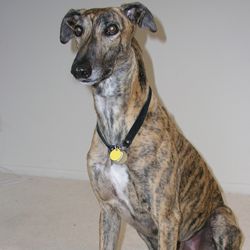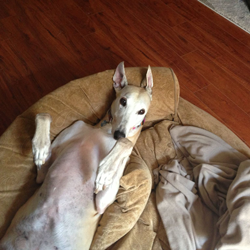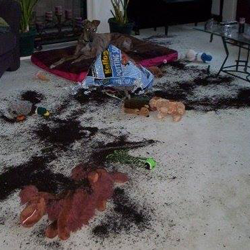TRAINING - BEHAVIOR: Greyhounds & Children

Dogs can be a wonderful addition to a child’s life. They can be a friend or a playmate. They can be fun and educational. And they can teach compassion and responsibility. The following information will promote a safe, enjoyable relationship between your child and a dog.
For Kids: Are You Ready for a Dog?
Before you decide that a greyhound is the right dog for you, you need to decide if a dog is the right new addition to your family. Click on this link to get a 23-page PDF file produced by The Gryphon Press: The Are You Ready for a Dog Kit. It includes check lists, a Readiness Quiz for Parents and another one for kids (both with answers), a Contract that the family can sign together to commit to what it takes to keep a dog happy and healthy, info on finding the right dog for you, and a number of other items.
For Kids: A Dog's-Eye View of the World
by Bonnie Jeffers
Use these fun activities to help your children understand the world from your dog’s point of view.
Have you ever thought about how your dog sees the world? Get down on your hands and knees to do these exercises.
1) Move around the house on your hands and knees.
Test what you can see--and what you can't see.
2) Call an adult into the room.
Look how big the person looks to you when you are down on the floor. You look at least that big to your dog.
3) Ask the adult to come running at you yelling something you can't understand.
How does that make you feel? Does it seem scary?
Your dog will feel afraid if you chase him or come running at him too fast. He may not want to be near you.
4) Ask the adult to tell you to do something without using any real words.
What if the person got mad because you didn't understand and do what was asked?
Your dog can't understand your words. You must teach him the words by gently showing him what they mean.
Rules for Dog/Child Interactions
by Bonnie Jeffers
According to the U.S. Center for Disease Control, more than 400,000 children each year receive dog bites requiring medical attention.
Here are more statistics from the American Humane Association's fact sheets:
Children can interact with dogs in a number of ways depending on the age of the child. He or she can help care for the dog and play with the dog. However, in order for the relationship to be enjoyable and safe for both the child and the dog, both must learn the rules.
Parents hold the ultimate responsibility for training their children and enforcing proper behavior around dogs 100% of the time; however, all dog owners are responsible to step in to protect their dogs if a child is acting inappropriately toward the dog.
For the safety of the child, as well as the dog, these rules need to be taught and enforced whenever a child interacts with a dog. If a child breaks one of these rules, punish the child…not the dog. For example, if the child is playing roughly with the dog, put the child in “time out,” don’t isolate the dog.
Greyhounds and Small Children
by Bonnie Jeffers
Like most rescue groups, GreySave does not generally adopt to people with children under the age of five. This has been a well-thought-through policy based on a great deal of experience and research. Although Greyhounds are usually calm, docile, and tolerant, here are a few of the reasons why we have found that Greyhounds are usually not a good match for a home with small children:
A young child is not able to safely and appropriately play with a dog. A dog is at its most playful when it is young. Therefore, adopting a dog when the child is too young (under age 5 or 6) means that both lose out. By the time the child can best play with the dog (around age 7-9), the dog has begun to slow down. Again, both lose out. Most heartbreaking is the fact that the dog generally dies when the child is at the age to be most attached, and emotional (pre-teen).
Waiting to adopt a dog until the child is 6 to 8 years old means that the dog and child are both at the most appropriate age for playing together. The child is also old enough to learn responsible care for the dog. The dog begins to slow down when the child is in the busy teen years and dies about the time the child goes off to college. While still difficult, the child is now old enough to better cope with the grief. This is a more natural, less traumatic, and more rewarding merging of the life stages of the dog and child.
It is also interesting to note that many sight hound adoption groups will not adopt to people with small children because the high pitched squeal of a small child is very similar to that of dying prey. This means that the “hunter” in the dog is constantly put on alert, a very anxious state of being for a pet to have to live in.
Having a dog in the house, any dog of any breed, with a small child is much like having a swimming pool. The interaction between the small child and dog must be monitored 100% of the time. Even if you think you know your dog and your child, taking a phone call or momentarily turning your back can bring serious consequences to one or both.
GreySave wants every Greyhound adoption to be an excellent match between the dog and the family. Our placement representatives want the Greyhound to fit well in your home so that all of your family members, as well as the Greyhound, safely enjoy the new relationship.
For Kids: Are You Ready for a Dog?
Before you decide that a greyhound is the right dog for you, you need to decide if a dog is the right new addition to your family. Click on this link to get a 23-page PDF file produced by The Gryphon Press: The Are You Ready for a Dog Kit. It includes check lists, a Readiness Quiz for Parents and another one for kids (both with answers), a Contract that the family can sign together to commit to what it takes to keep a dog happy and healthy, info on finding the right dog for you, and a number of other items.
For Kids: A Dog's-Eye View of the World
by Bonnie Jeffers
Use these fun activities to help your children understand the world from your dog’s point of view.
Have you ever thought about how your dog sees the world? Get down on your hands and knees to do these exercises.
1) Move around the house on your hands and knees.
Test what you can see--and what you can't see.
2) Call an adult into the room.
Look how big the person looks to you when you are down on the floor. You look at least that big to your dog.
3) Ask the adult to come running at you yelling something you can't understand.
How does that make you feel? Does it seem scary?
Your dog will feel afraid if you chase him or come running at him too fast. He may not want to be near you.
4) Ask the adult to tell you to do something without using any real words.
What if the person got mad because you didn't understand and do what was asked?
Your dog can't understand your words. You must teach him the words by gently showing him what they mean.
Rules for Dog/Child Interactions
by Bonnie Jeffers
According to the U.S. Center for Disease Control, more than 400,000 children each year receive dog bites requiring medical attention.
Here are more statistics from the American Humane Association's fact sheets:
- 50% of dog attacks involve children under 12 years old
- 82% of dog bites treated in the emergency room involve children under age 15
- 70% of dog-bite fatalities occurred among children under 10 years old
- Unsupervised newborns are 370 times more likely than an adult to be killed by a dog.
Children can interact with dogs in a number of ways depending on the age of the child. He or she can help care for the dog and play with the dog. However, in order for the relationship to be enjoyable and safe for both the child and the dog, both must learn the rules.
Parents hold the ultimate responsibility for training their children and enforcing proper behavior around dogs 100% of the time; however, all dog owners are responsible to step in to protect their dogs if a child is acting inappropriately toward the dog.
For the safety of the child, as well as the dog, these rules need to be taught and enforced whenever a child interacts with a dog. If a child breaks one of these rules, punish the child…not the dog. For example, if the child is playing roughly with the dog, put the child in “time out,” don’t isolate the dog.
- Never hit, kick, push, or play roughly with a dog.
- Don’t touch a dog’s ears, eyes, nose, mouth, or under his tail.
- Don’t hug or squeeze a dog around the neck.
- Don’t squeal or scream around a dog.
- Never tease a dog, for example, by showing him a treat or toy and then pulling it away.
- Never take food, a toy, or anything else out of a dog’s mouth.
- Never approach a dog that is eating or sleeping.
- Remember that the dog’s bed is his “leave me alone” zone. Don’t touch or bother him when he is there.
- Always ask before petting a dog you do not know, and always let the dog smell you before you touch him.
Greyhounds and Small Children
by Bonnie Jeffers
Like most rescue groups, GreySave does not generally adopt to people with children under the age of five. This has been a well-thought-through policy based on a great deal of experience and research. Although Greyhounds are usually calm, docile, and tolerant, here are a few of the reasons why we have found that Greyhounds are usually not a good match for a home with small children:
- Dog’s Temperament: These are adult dogs and, although there are exceptions, they don’t generally play with a child like a lab or retriever might.
- Dog’s Speed: These dogs can reach 45 mph in three steps. A small child’s brief error in opening a door can be fatal if the dog slips out.
- Dog’s Needs: Dogs have the emotional and mental needs of a 2- to 3-year-old child. Is the parent able and willing to put in the effort associated with having another “toddler” in the house.
- Child’s Best Interest: The classic romantic notion of a dog and baby growing up together does not square with reality. It is not only NOT in the best interest of the dog, but also not in the best interest of the child. Here is what I mean:
A young child is not able to safely and appropriately play with a dog. A dog is at its most playful when it is young. Therefore, adopting a dog when the child is too young (under age 5 or 6) means that both lose out. By the time the child can best play with the dog (around age 7-9), the dog has begun to slow down. Again, both lose out. Most heartbreaking is the fact that the dog generally dies when the child is at the age to be most attached, and emotional (pre-teen).
Waiting to adopt a dog until the child is 6 to 8 years old means that the dog and child are both at the most appropriate age for playing together. The child is also old enough to learn responsible care for the dog. The dog begins to slow down when the child is in the busy teen years and dies about the time the child goes off to college. While still difficult, the child is now old enough to better cope with the grief. This is a more natural, less traumatic, and more rewarding merging of the life stages of the dog and child.
It is also interesting to note that many sight hound adoption groups will not adopt to people with small children because the high pitched squeal of a small child is very similar to that of dying prey. This means that the “hunter” in the dog is constantly put on alert, a very anxious state of being for a pet to have to live in.
Having a dog in the house, any dog of any breed, with a small child is much like having a swimming pool. The interaction between the small child and dog must be monitored 100% of the time. Even if you think you know your dog and your child, taking a phone call or momentarily turning your back can bring serious consequences to one or both.
GreySave wants every Greyhound adoption to be an excellent match between the dog and the family. Our placement representatives want the Greyhound to fit well in your home so that all of your family members, as well as the Greyhound, safely enjoy the new relationship.










